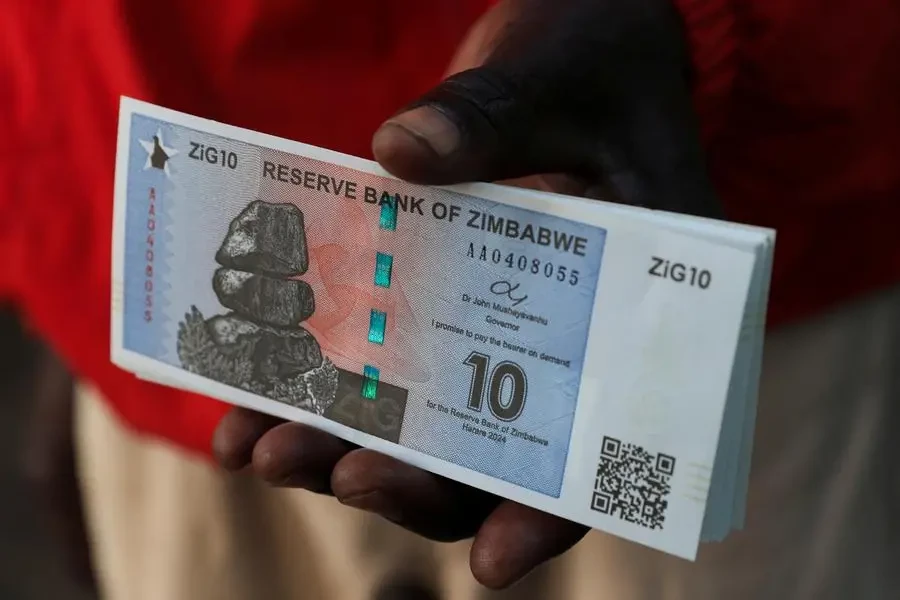
PRICES of basic commodities have risen sharply as the recently launched Zimbabwe Gold (ZiG now ZWG) currency stutters in a United States dollar-dominated market, with shops now preferring to charge their goods exclusively in foreign currency.
The Reserve Bank of Zimbabwe (RBZ) launched the ZWG trading at 13,56 to the US dollar on April 5 this year before it shed 0,8% in May.
While monetary authorities have painted a rosy picture on the new currency, the shortages of the ZWG notes have since forced retailers to charge their prices in US dollars.
According to a snap survey conducted in Harare, retailers, who have been displayingprices in both the ZWG and US dollars, have since started charging exclusively in the greenback.
The ZWG shortage has also forced the general public to resort to the US dollar as a store of value and paying for goods and services in the foreign currency.
The survey revealed a steady rise of prices especially in the local currency, which has since been pegged at US$1:ZWG14,8.
The foreign exchange rate on the informal market has remained high, ranging between ZWG24 and ZWG28 per US dollar.
Some of the basic commodities like flour and mealie-meal are scarce in supermarkets, where some retailers with the goods have removed price tags in the local currency.
- Rampaging inflation hits Old Mutual . . . giant slips to $9 billion loss after tax
- Monetary measures spur exchange rate stability: RBZ
- Zim deploys IMF windfall to horticulture
- Banker demands $21m from land developer
Keep Reading
For example, a 2-litre bottle of cooking oil is going for US$5, a 10kg bag of mealie-meal (US$11), 2kg packet of sugar (US$3), 2-litre bottle of Mazoe Orange Crush (US$7), 2kg packet of rice (US$4,40) and 2kg packet of flour (US$2,80) in supermarkets
The survey also revealed that tuckshops had become cheaper than supermarkets, with basic commodities such as 2 litres of cooking oil going for US$3,30, 2kg sugar (US$2,50), 2kg flour (US$1,90), Mazoe Orange Crush (US$4) and 2kg rice (US$2,30).
The Consumer Protection Commission (CPC) yesterday expressed concern over the sudden spike in the price of goods and services in the past few weeks, in US dollar and ZWG terms.
CPC spokesperson Kuda Mudereri said the commission had engaged relevant stakeholders so that appropriate action is taken to address the anomaly.
He said if left unattended, consumers would be on the receiving end.
“During its market surveillance, the commission noted that cooking oil, whose price was ranging between US$3 and US$3,50, is now ranging between US$4,40 and US$4,80 in major retail outlets such as OK, Pick n Pay and Spar, among others,” Mudereri said.
“The increase in prices of basic commodities is more evident in large supermarkets as compared to small shops.
“Our private investigations point to the fact that this might be so because these big shops want to insulate themselves against exchange losses arising from the widening gap between official exchange rate and the parallel market exchange rates, which has moved from 30% to 48%.”
According to the commission, the main challenge on the markets was that most shops were still indexing their prices in foreign currency, particularly in US dollars.
Mudereri said the commission’s market surveillance team had noted that the ZWG has depreciated in the parallel market by 30% over two weeks, moving from US$1:ZWG20 to US$1:ZWG26.
“In some areas such as Hwange, Nkayi, Lupane, Dete, trading is at an obscene rate of US$1:ZWG35, which has caused mayhem, with prices shooting through the roof.
Mudereri said the commission had been issuing business with compliance notices to stop charging exchange rates which are above official rates.
Confederation of Zimbabwe Retailers president Denford Mutashu told NewsDay yesterday that the supply chain was distorted, leading to the challenges in the sector.
“Formal retailers are struggling to restock with the local currency as suppliers seek payment in US dollars and are unable to sell goods in local currency at the prevailing exchange rates,” he said.
“Formal retail is increasingly being replaced by informal trade, which is not only unregulated, but enjoys zero enforcement. Retailers, wholesalers and manufacturers are sitting on huge stocks of ZWG they cannot use to procure stocks.”
Economist Chenayimoyo Mutambasere cautioned authorities to look at the ZWG saying its introduction was always going to be problematic.
“A local currency that lacks the stability of fiat money and is, instead, backed by vague policy attributes, under the guise of a structured currency, signals a lack of confidence in our economy by the policymakers themselves,” she said.
“The ZWG was essentially a response to the Treasury’s liquidity crisis, achieved by printing a new currency to settle contractor bills. Policymakers then tried to enforce its acceptance through outdated measures, such as the arrest of money changers.”
Another economist, Stevenson Dhlamini, attributed the steady rise in the price of basic commodities to “the front load pricing by retailers who are not using the official exchange rate in their pricing”.
“The disappearance of some products may be caused by the disruption of the supply chain by informal traders who are creating unfair competition for large retailers,” he said.
Dhlamini said the authorities should increase efforts to liberalise the foreign exchange market to improve the price discovery mechanism for the local currency.
“The two weeks plus time lag in foreign currency allotments is disrupting supply chains and promoting the informalisation of the economy especially in the retail industry,” he said.







